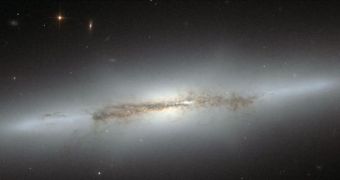Using the Advanced Camera for Surveys (ACS) instrument aboard the newly refurbished Hubble Space Telescope, astronomers have recently snapped an amazing, highly detailed image of the galaxy NGC 4710. In its analysis of the images, the team discovered that the structure revealed an X-shaped bulge that was uncharacteristic of such galaxies, according to AlphaGalileo. The bulge can be clearly seen in the formation's bright, central region. Such structures were noticed in other galaxies as well, but mostly in spiral galaxies with opened arms, as opposed to the tightly packed formation that is the NGC 4710, astronomers say.
The elongated plane that can be seen in this image accompanying the central bulge at the middle of the galaxy is known as the galactic disk. Massive dust lanes, drawn towards the structure by its gravitational pull, can also be seen orbiting around, creating an eerie appearance. While carefully looking at the central parts of the image, astronomers made out a faint, X-shaped structure, which is usually referred to as a “boxy” or “peanut-shaped” bulge. Just like the structures in Saturn's rings that are only visible during the equinox, so too these bulges can only be observed from the Earth when the galaxy is edge-on to our location.
Astronomers believe that the formations may be caused by the vertical motions of the stars inside the galactic bar. The reason why the experts were surprised to find the X-shaped bulge was the fact that formations of this type seldom occurred in galaxies that had arms tightly wrapped around a large central bulge, as was the case with NGC 4710. In most instances, bulges are seen in galaxies with smaller cores, and with their arms more widely spaced from each other. The recently observed portion of the sky is located in the giant Virgo Cluster of galaxies, in the northern constellation of Coma Berenices.
It lies some 60 million light-years away from the Earth, and was discovered by famous astronomer William Herschel, in the 1780s. Originally, the scientist gave it the name of “faint nebula,” although the structure is large enough to be seen in the night sky with an average-sized telescope. What's fairly peculiar about this galaxy is the fact that it looks both like a spiral- and a barrel-type structure, a “model” known as an SO galaxy.

 14 DAY TRIAL //
14 DAY TRIAL //